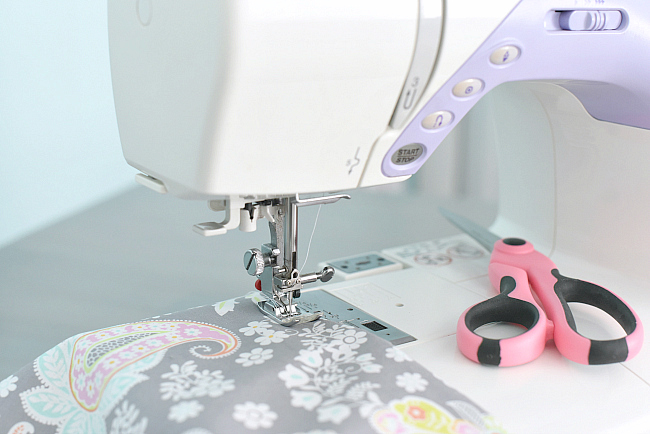Sewing for Beginners

Sewing for beginners can seem daunting at first. These basic sewing skills will make your life much easier. To move on to more complex projects, it is worth learning basic sewing patterns. Here are some tips to help you get started with sewing.
Master These Basic Sewing Skills!
The Sewing Lingo:
Do you know the expression, “Walk before your run?” Well, I would suggest that you learn the terminology before you jump in.
You can learn them while on the job. It would be convenient to have a dictionary at your side when you are working on a project. An online class is a great option if you want to sharpen your skills.
Be comfortable:
Some sewing projects can take several hours, even days. They can also create a mess for beginners who are just starting to learn basic sewing skills. For beginners, the best advice is to find a place in your home where you can do your hobby without interruptions.
You can choose your best friend — Your sewing machine:
Sewing machines come in different sizes and specifications. Each model is tailored to different needs. It is important to choose the best and worthy sewing machine that suits you most. It will be your constant companion as you sew.
The Sewing Course for Beginners:
Understanding Your Sewing Machine is the Next Step. You can learn how to use this machine and improve your sewing machine skills.
How to Insert and Remove a Sewing Needle
For all sewers, getting poked by a needle is a right of passage. My sewing machine needle has been damaged more than once, and I have had to replace it several times.
Inserting and taking out needles is essential to know correctly in order to avoid such accidents. However, an automatic needle threader can work the best for you. Therefore, choose a model such as brother lx3817 sewing machine.
How to adjust your sewing machine model’s tension:
This is a sewing tutorial for beginners. How your stitches come out depends on how tension is set by your sewing machine. An incorrect sewing machine tension can cause your stitches not to come outright. This is something we wouldn’t want, would it?
Thread your Sewing Machine:
It can seem complicated to thread your sewing machine. This is especially true for beginner sewists who are just starting to sew.
It’s easy to do if you follow these simple instructions. Even sewing machines come with numbered parts that can be used to help you.
Select the Right Sewing Needle:
Just like sewing machines, there are different types of needles for different tasks. A regular point needle is not suitable for quilting.
It would break. Broken needles are not fun to find under layers of fabric scraps. Grab this great pack of needles.
Beginning Sewing & Choosing the Right Thread:
Not all combinations are equal. Some combinations are only compatible with one another.
This is true for choosing the right thread to match different fabrics. It is best to get familiar with them before you spend a lot of time on a silk project that uses a cotton thread.
AS a beginner, singer 4423 reviews can suggest to you how this model can be the best fit for you.
Sewing for beginners in hand sewing: Before my first sewing machine, every project I made was done by hand sewing. It was difficult to learn how to sew step-by-step by hand. This required more attention to detail. It can be frustrating. It’s a skill that beginners need to learn.
Hand Sewing Techniques: There are many hand sewing techniques that make it much easier and more efficient. You can use hairspray to make it easier to thread through a needle.
Basic Stitches for Beginners:
There are two types of basic stitches. There are two types of basic stitches: the hand-sewn and the machine stitches.
These basic stitches will teach you the basics of sewing for beginners. From the running stitch to the blanket stitch. These will assist you in starting (and finishing) your first project.
Sew Straight Stitches: Straight stitches can be made using a sewing machine. This is basic stitches way. It’s not difficult to sew, but don’t let that fool you. This stitch is actually one of the most versatile!
The Sew A Zigzag Stitch:
It’s another type that can be made with a sewing machine. Zigzag stitches can be used for decorative purposes. They are strong and can hold the fabric together. You can make sure that your seam is not ruined by a Zigzag Stitches Foot. This stitch can be used with the Zigzag Stitches Foot.
Gathering Fabric Sewing:
Gathering is a technique that I have been enthralled with since my first ruffled skirt. You can also do it by hand. It’s also a basic skill that you should learn to use a sewing machine. This is a great skill to add to your list of sewing tips for beginners.
Sew a Zipper: Zippers make up a large part of many kinds of clothing and accessories. They are used in fashion staples like dresses, pants, and bags. It is impossible to ignore learning how to sew it. It is also important to sew it correctly! You don’t want a zipper mishap, do you?
Sew a Button: Every sewer who is worth their salt must master the art and science of sewing buttons. Buttons are everywhere! They’re all over our tops, pants, and dresses. Use fun, complementary threads to make sewing buttons more fun!
Sew a French Seam: This might sound like something that is meant for advanced sewists. It’s actually part of the sewing guide for beginners. It’s just a matter of tucking in the raw edges and sewn shut. Your project will have a classic and polished look with the French seam.
How to sew mitered corners: Mitered corners look like flat piping but are flatter and wider. These are great for square and rectangular projects. They will look polished and more expensive. This technique can be used for your next table runner project.
Scalloped edges: These are adorable! The scallop-edged skirt that I made my daughter last Christmas is her favorite. This technique can be used to add a feminine touch to any project.
Sewing for Beginners:
I still use patterns for some of my sewing projects. These patterns are easy to use and great for beginners looking to learn new things.
Follow the instructions, and you will soon be creating your own patterns. You can then move on to more difficult patterns once you are comfortable with the process.
Sewing for beginners in embroidery stitches:
According to my experience, embroidery can be one of the most difficult types of needlework. I used to be intimidated by the stitches. However, I discovered that sewing and embroidery stitches share a lot.
To succeed in embroidery, patience and practice are key. This is also true for sewing for beginners. If you wanna practice on this grounds, choose a model such as brother cs6000i.
The blanket stitch is similar to the one used in sewing. A blanket embroidery stitch is applied to the fabric’s edge. You can give the fabric a polished appearance by framing it in the thread color you choose.
Cross Stitch Sewing: Cross stitching is a sub-group of sewing. It can be used in embroidery, traditional sewing, and even as a basic stitch. This is a good skill to have in case you need it.
The Purl Stitch: A tutorial for beginners in knitting (Purl Stitch). If you are more interested in knitting than in embroidery, the purl stitch is for you. It is the most popular stitch in knitting. It is easy to learn and looks great when done correctly.
Read more : Wear Brown Street wear for Men in A Trendy Way.






